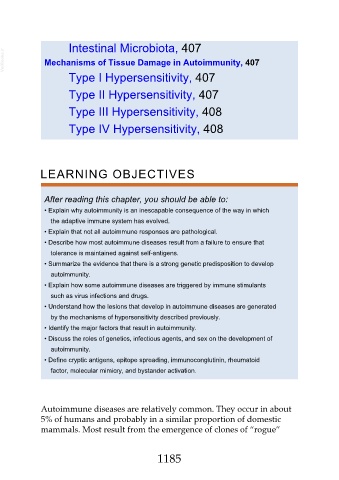Page 1185 - Veterinary Immunology, 10th Edition
P. 1185
Intestinal Microbiota, 407
VetBooks.ir Mechanisms of Tissue Damage in Autoimmunity, 407
Type I Hypersensitivity, 407
Type II Hypersensitivity, 407
Type III Hypersensitivity, 408
Type IV Hypersensitivity, 408
LEARNING OBJECTIVES
After reading this chapter, you should be able to:
• Explain why autoimmunity is an inescapable consequence of the way in which
the adaptive immune system has evolved.
• Explain that not all autoimmune responses are pathological.
• Describe how most autoimmune diseases result from a failure to ensure that
tolerance is maintained against self-antigens.
• Summarize the evidence that there is a strong genetic predisposition to develop
autoimmunity.
• Explain how some autoimmune diseases are triggered by immune stimulants
such as virus infections and drugs.
• Understand how the lesions that develop in autoimmune diseases are generated
by the mechanisms of hypersensitivity described previously.
• Identify the major factors that result in autoimmunity.
• Discuss the roles of genetics, infectious agents, and sex on the development of
autoimmunity.
• Define cryptic antigens, epitope spreading, immunoconglutinin, rheumatoid
factor, molecular mimicry, and bystander activation.
Autoimmune diseases are relatively common. They occur in about
5% of humans and probably in a similar proportion of domestic
mammals. Most result from the emergence of clones of “rogue”
1185

